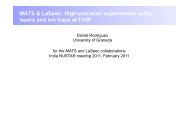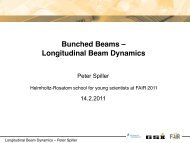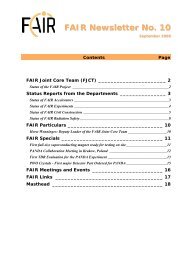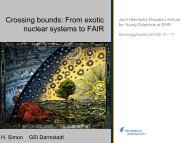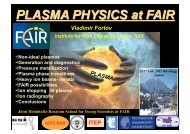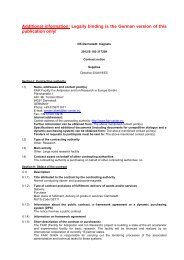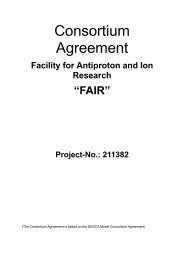CRYRING@ESR - Facility for Antiproton and Ion Research
CRYRING@ESR - Facility for Antiproton and Ion Research
CRYRING@ESR - Facility for Antiproton and Ion Research
Create successful ePaper yourself
Turn your PDF publications into a flip-book with our unique Google optimized e-Paper software.
34 Chapter 7. Project Steering<br />
Darmstadt in the beginning of 2013. It is planned that a small group from GSI will be invited<br />
by MSL to spend some months in Stockholm during the autumn 2012 to participate in the<br />
final disassembly <strong>and</strong> packing of the CRYRING in order to gain experience about the configuration<br />
of CRYRING be<strong>for</strong>e the disassembly. This experience would help considerably <strong>for</strong> an<br />
optimal reassembly of the ring at GSI. It should be remarked that the fact that the CRYRING<br />
is available intact <strong>and</strong> properly modified according to the requirements defined by the FLAIR<br />
collaboration has been accomplished by a large grant from the Swedish <strong>Research</strong> Council <strong>and</strong> by<br />
generous support from Stockholm University, both acknowledging the high scientific potential<br />
of the future use of the CRYRING at GSI/FAIR. The leader of the MSL team is the accelerator<br />
physicist Anders Källberg, who through the years has been responsible <strong>for</strong> the operation of the<br />
CRYRING at MSL. In addition to the CRYRING hardware described in the TDR, Stockholm<br />
University has recently offered an advanced internal gas target system <strong>for</strong> CRYRING experiments<br />
to be delivered with a ring. This opens new scientific opportunities which have attracted<br />
a substantial interest from physicists planning future experiments at <strong>CRYRING@ESR</strong>. After<br />
the transportation of CRYRING to Darmstadt, there are hitherto no <strong>for</strong>mal commitments <strong>for</strong><br />
a Swedish participation in its installation at the ESR. However Stockholm University offers<br />
that two experienced accelerator physicists, a highly qualified engineer, expert on the CRY-<br />
RING Control System <strong>and</strong> a mechanical engineer will spend up to in total two person-years<br />
at GSI/FAIR. Dependent on the success of applications of further financial support from the<br />
Swedish <strong>Research</strong> Council (application sent to the Council <strong>for</strong> <strong>Research</strong> Infrastructures in April<br />
2012 by the board of SFAIR, the “umbrella organization” of Swedish scientists aiming <strong>for</strong> using<br />
FAIR) <strong>and</strong> the Knut & Alice Wallenberg Foundation (see below), Swedish presence in the<br />
installation <strong>and</strong> commissioning work might be increased.<br />
7.6 Swedish Participation in Experiments at FAIR: <strong>CRYRING@ESR</strong><br />
The new exciting scientific opportunities that can be offered soon with an early installation<br />
of the <strong>CRYRING@ESR</strong> have stimulated Swedish scientists to plan <strong>for</strong> experiments at the new<br />
facility. A team of Atomic Physicists from Chalmers University of Technology, Gothenburg <strong>and</strong><br />
Stockholm University, as well as Nuclear Physicists from Chalmers <strong>and</strong> Lund University <strong>and</strong><br />
Accelerator Physicists from Stockholm University <strong>and</strong> ESS, Lund are preparing an application<br />
to the Knut & Alice Wallenberg Foundation <strong>for</strong> travel costs <strong>and</strong> stationing of personnel <strong>for</strong><br />
extended periods of time at GSI/FAIR. Scientific issues that are planned to be addressed are<br />
within the areas: Atomic-ion collisions, <strong>Ion</strong>-photon collisions <strong>and</strong> nuclear <strong>and</strong> nuclear astrophysics<br />
experiments. An important part of the application is also positions <strong>for</strong> two postdoctoral<br />
researchers, who should work on<br />
1. starting up research development on experiments <strong>and</strong> detectors with a focus on nuclear<br />
reactions <strong>and</strong> nuclear astrophysics <strong>and</strong><br />
2. ion-optical problems, in particular optimization of the transmission of radioactive beams<br />
into the ESR.<br />
The main applicant, PI, <strong>for</strong> the application to the Knut & Alice Wallenberg Foundation is<br />
Andreas Heinz, nuclear physicist at Chalmers University of Technology.



